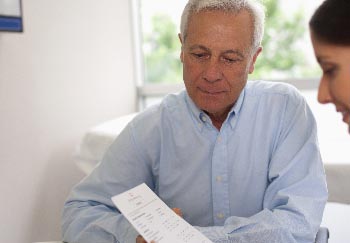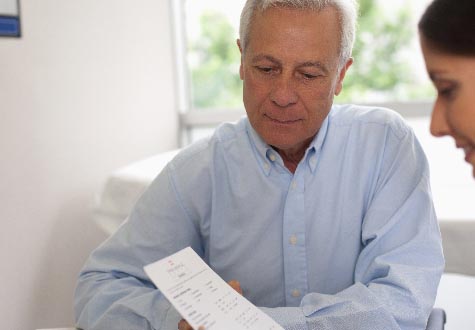
If you’re unsure why you should bother with a colon cancer screening, you’re not alone. There aren’t too many ribbons or fundraisers for colorectal cancer prevention. We don’t typically talk about our digestive health in polite conversation.
But March is Colorectal Cancer Awareness Month, and we need to be talking about it. Colorectal cancer is the third leading cause of cancer-related deaths in the U.S., according to the American Cancer Society. That means that in 2018, about 50,000 people will die from colon, anal or rectal cancer.
And yet, it’s often preventable. Bryan Sauer, MD, says doctors find small growths called colon polyps in about one-third of the colonoscopies they do in men, one-fourth for women. Although the polyps themselves usually aren’t cancerous, they may develop into cancer if doctors don’t remove them.
This is why, four years ago, the National Colorectal Cancer Roundtable set a goal of screening 80 percent of people age 50 and above by 2018. But in Virginia, the number getting screened is still more like 66 percent, Sauer says.
Who Should Be Screened for Colon Cancer?
Everyone 45 and older should get screened. Once you’ve had your first screening, you may be able to wait up to 10 years before the next one, depending on the results and what kind of screening you got.
If you have a first-degree relative (mother, father) or several second-degree relatives (grandparents, aunts, uncles) who have had colon cancer, you should talk to your doctor about being screened at a younger age.
Sauer has a few thoughts on why so many Virginians aren’t getting screened:
- Screening can be uncomfortable, emotionally and physically
- They lack a primary care provider to discuss colon cancer screening options
Colonoscopies and Colonoscopy Alternatives
You’re probably familiar with colonoscopies, which involve inserting a flexible tube with a tiny camera into your rectum to examine the entire colon for polyps.
“Our goal isn’t really to find cancer, because that’s much more unlikely,” Sauer says. “Our goal is to find the polyps that are precursors to cancer, and then remove them before they turn into cancer.”
You must be sedated during the procedure. At UVA, doctors typically insert carbon dioxide into the colon to help with the procedure, which causes less pain than air, Sauer says. Patients typically don’t experience much pain afterward. They can quickly begin eating and drinking and go back to work the next day.
The procedure itself isn’t too bad, but colonoscopy prep has a bad reputation.
- One week before the procedure, you’ll decrease your fiber intake.
- The day before the procedure, you’ll stop eating solid foods and drink a gallon of a salty solution. (Sometimes you can get a different formula and avoid drinking as much, but this option may be more expensive.)
- The solution will cause you to have bowel movements and eventually diarrhea to empty out your colon.
Although the prep isn’t fun, colonoscopies are still the gold standard for colon cancer screening. As Sauer points out, it’s only two days. If the colonoscopy doesn’t find any polyps or other problems, you can wait 10 years before your next one.
However, if you really can’t stomach a standard colonoscopy, there are other colon cancer screenings to talk to your doctor about.
Stool-Based Tests
These tests look for blood and certain proteins in your stool that could indicate cancer. If it finds blood, you’ll then need a colonoscopy for further diagnosis.
Stool-based tests used to have a high false positive rate, Sauer says, but they’ve gotten better and are a good option for people who would rather avoid a colonoscopy. However, if you do end up needing a colonoscopy, your insurance may not cover it. You also need to get fecal tests more frequently than a screening colonoscopy — every 1-3 years.
Some of these tests can be done at your doctor’s office. With a fecal DNA test, you get a stool sample at home and send it directly to a lab. That test looks for both blood and altered DNA that indicates cancer.
Virtual Colonoscopy
Virtual colonoscopies involve using a CT scanner and computer software to see inside the body without having to insert a long tube into the colon. However, you still have to do prep, which Sauer says is the reason most people don’t want to get colonoscopies.
Need a Colon Cancer Screening?
If you’re 45+ or have relatives who’ve had colon cancer, talk to your primary care provider about screening options. Don’t have one? Find a PCP in Charlottesville or central Virginia.
Additionally, it’s not as accurate as a colonoscopy, and doctors can’t remove polyps during the exam. If they find any, they’ll have to follow up with a conventional colonoscopy to remove them.
Flexible Sigmoidoscopy
You may have heard of this procedure as a colonoscopy alternative. While it’s similar, it only looks at one-fourth of your colon, so doctors no longer use it to screen for colon cancer.
“I think if you’re willing to undergo a screening procedure and undergo a flexible sigmoidoscopy, the difference between that and a full colonoscopy is not all that significant,” Sauer says.
Just Get Tested
The bottom line, Sauer says, is that if you forgo screening, “you’re playing with fire.” Colorectal cancer symptoms — low blood counts, weight loss, inability to pass stool — usually don’t appear until the cancer is advanced and hard to treat. But screening finds polyps before they become cancerous, and doctors can easily remove them.
“I think the most important thing is to get screened,” Sauer says. “Have a discussion with your doctor, and then make a decision on the best screening test for you.”
